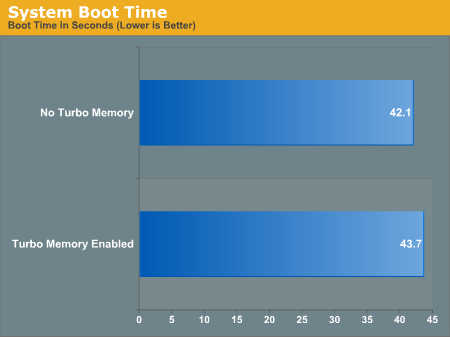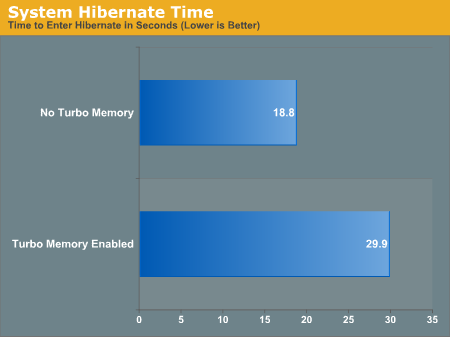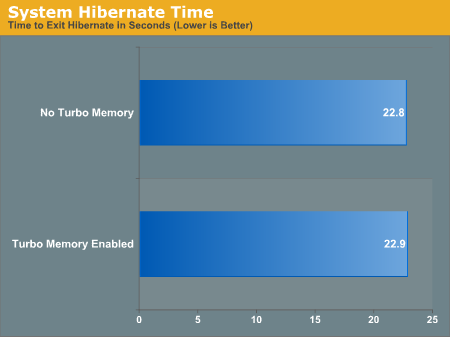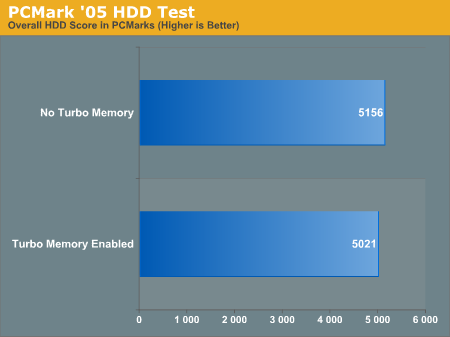Intel Santa Rosa Preview: Centrino V Evolves
by Anand Lal Shimpi on May 10, 2007 12:00 AM EST- Posted in
- Laptops
Testing Turbo Memory:
On paper, Intel's Turbo Memory appears to be a sure win and seemingly the type of thing you'd want on every system. The problem is that despite what you'd expect, we have yet to see any tangible performance increase from using Intel's Turbo Memory.

Not only did boot times not improve with our Santa Rosa test platform (sent to us by Intel), but enabling Intel Turbo Memory caused the system to take even longer to hibernate than with it disabled:


Intel confirmed that the system it sent us saw no improvement in system boot times, but the blame was placed on the manufacturer of the whitebook system. According to Intel, something in the BIOS was implemented incorrectly causing a lack of positive impact due to Turbo Memory. Intel couldn't get us an explanation as to why our hibernation results were what they were.
Intel did say that other reference designs and its customers products appear to show clear benefits with Turbo Memory enabled; why Intel did not choose to send one of these working products for review is beyond our scope of understanding.
We ran our entire benchmark suite with Turbo Memory enabled as well as disabled, hoping to find a situation where the additional flash memory would be useful but alas we were left with nothing. We even turned to PCMark '05 and its HDD test suite, once again hoping for something positive to look forward to:

As you can see above, we were once again left with nothing. According to Intel, we should be seeing somewhere around a 15% improvement in the PCMark '05 HDD test but we simply couldn't find it. We tried reinstalling the drivers, OS, benchmarks, anything and everything to get good results out of Intel's Turbo Memory but were met with nothing but disappointment.
On paper, Intel's Turbo Memory appears to be a sure win and seemingly the type of thing you'd want on every system. The problem is that despite what you'd expect, we have yet to see any tangible performance increase from using Intel's Turbo Memory.

Not only did boot times not improve with our Santa Rosa test platform (sent to us by Intel), but enabling Intel Turbo Memory caused the system to take even longer to hibernate than with it disabled:


Intel confirmed that the system it sent us saw no improvement in system boot times, but the blame was placed on the manufacturer of the whitebook system. According to Intel, something in the BIOS was implemented incorrectly causing a lack of positive impact due to Turbo Memory. Intel couldn't get us an explanation as to why our hibernation results were what they were.
Intel did say that other reference designs and its customers products appear to show clear benefits with Turbo Memory enabled; why Intel did not choose to send one of these working products for review is beyond our scope of understanding.
We ran our entire benchmark suite with Turbo Memory enabled as well as disabled, hoping to find a situation where the additional flash memory would be useful but alas we were left with nothing. We even turned to PCMark '05 and its HDD test suite, once again hoping for something positive to look forward to:

As you can see above, we were once again left with nothing. According to Intel, we should be seeing somewhere around a 15% improvement in the PCMark '05 HDD test but we simply couldn't find it. We tried reinstalling the drivers, OS, benchmarks, anything and everything to get good results out of Intel's Turbo Memory but were met with nothing but disappointment.










22 Comments
View All Comments
Lord Evermore - Saturday, May 12, 2007 - link
Mobile sockets are just oh so cute!Just what we needed. A nice new proprietary memory card that you can only get from an OEM included in a system. What actual interface type does it use? Can the amount of the flash that's reserved for ReadyBoost or ReadyDrive be changed? Seems kind of stupid if not, a total waste of half the flash you paid for. Even with 1GB completely available, in some cases that will be useless for speeding up hibernation since it might not be enough to store the system state.
For that matter, if you've got the money to be buying the flash, which is guaranteed to be more expensive than a 1GB flash thumbdrive, wouldn't you be buying with enough memory to start with, and possibly also getting a hybrid hard drive that already had flash (possibly more than just a piddly 1GB)? Really I still just don't see a point other than to sell more flash memory. Put more DRAM into the drives, they need it. With enough memory in the system, you already have a disk cache in memory that can be used for the often-needed data, which is faster than even the Flash. One of the big things with Vista is how it always seems to be using so much memory, and this is exactly the reason.
IS 802.11n ever actually going to be finalized? Or have they contracted beta-fever from software developers? And dang, that laptop maker is serious about keeping that wireless card in place.
coolme - Wednesday, May 16, 2007 - link
The intel turbo memory module uses PCI express x1 interface.The major thing about flash is that it's non-volatile meaning that it can be used for boot-up and/or hibernation sequences.
jediknight - Thursday, May 10, 2007 - link
There were really three things I wondered about this platform:1) Performance of robson
2) Performance of GMA X3000
3) Battery life improvements
None of which were answered in this one.
I second the suggestion to hold off on reviews until you have something to really.. review.
IntelUser2000 - Thursday, May 10, 2007 - link
The power consumption figures are certainly interesting. The only difference between two systems is the video cards and the CPU, and I doubt the Geforce 8600M consumes less idle power than the Radeon X1600. The power consumption figures indicate there may be a battery life increase of 25-30%.rexian96 - Thursday, May 10, 2007 - link
Many questions posted above & none answered. Well, I'll add mine. Are these new T7300 processors compatible with current socket 479? Did I miss it or the article never talked about it.Freddo - Thursday, May 10, 2007 - link
On the second page; "Despite the minor changes to the CPU, Intel has introduced a new socket pinout with Santa Rosa, meaning that these new Merom chips won't work in older platforms and vice versa."TA152H - Thursday, May 10, 2007 - link
What a worthless review.Why even bother with it? If Intel is too arrogant to provide something worthwhile, why do them the favor of reviewing their item. Am I missing something here? They send an item with two big changes - a new IGP and a new solid state memory that is supposed to be the greatest thing since Cheddar Cheese, and neither can be reviewed properly. It's either the height of audacity or stupidity, and I don't think they're stupid. My guess is they just want press for their items without having to reveal too much, assuming there is anything rational about it. I don't get it.
I wouldn't do them the favor of even reviewing stuff like this. They get exposure, albeit not particularly positive, and they give essentially nothing. If they want to play weird games, let them play it alone. Sending something like this is just arrogant.
mongoosesRawesome - Thursday, May 10, 2007 - link
How does linux support the Robson technology? Does it see half the memory as part of the hard drive?solipsism - Thursday, May 10, 2007 - link
Is it 8GB or are we stuck with the same 4GB limitation as in the 945PM chipset?
solipsism - Friday, May 11, 2007 - link
It's still a 4GB maximumPage 30 :: http://cache-www.intel.com/cd/00/00/33/40/334087_3...